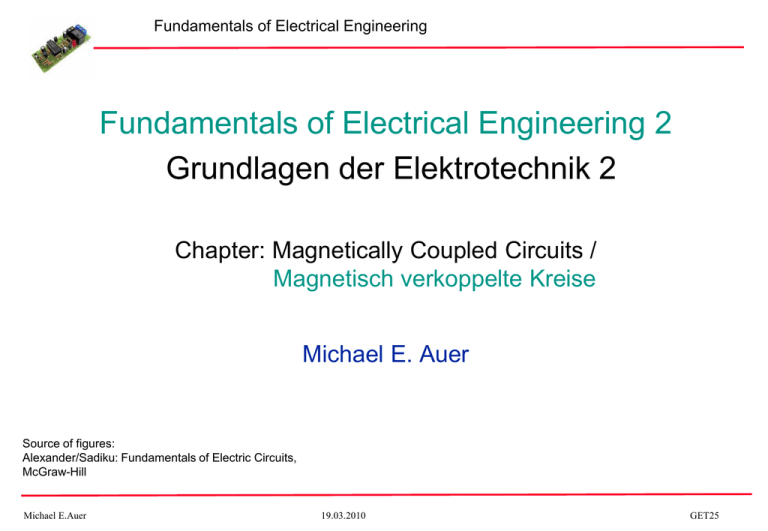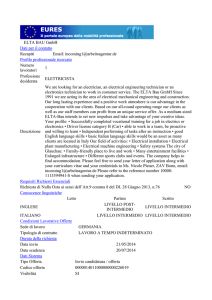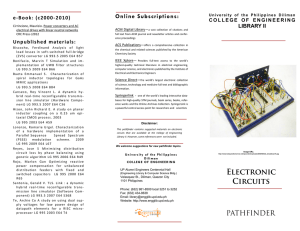Fundamentals of Electrical Engineering 2 Grundlagen der
advertisement

Fundamentals of Electrical Engineering Fundamentals of Electrical Engineering 2 Grundlagen der Elektrotechnik 2 Chapter: Magnetically Coupled Circuits / Magnetisch verkoppelte Kreise Michael E. Auer Source of figures: Alexander/Sadiku: Fundamentals of Electric Circuits, McGraw-Hill Michael E.Auer 19.03.2010 GET25 Fundamentals of Electrical Engineering Course Content Sinusoids and Phasors / Harmonische Funktionen und Zeiger Sinusoidal Steady State Analysis / Netzwerkanalyse bei harmonischer Erregung Frequency Response Analysis / Frequenzgang Analyse AC Power / Leistung in Wechselstromkreisen Magnetically Coupled Circuits / Magnetisch verkoppelte Kreise Michael E.Auer 19.03.2010 GET25 Fundamentals of Electrical Engineering Chapter Content Mutual Inductance / Gegeninduktion Transformers / Transformatoren Applications / Anwendungen Summary / Zusammenfassung Michael E.Auer 19.03.2010 GET25 Fundamentals of Electrical Engineering Chapter Content Mutual Inductance / Gegeninduktion Transformers / Transformatoren Applications / Anwendungen Summary / Zusammenfassung Michael E.Auer 19.03.2010 GET25 Fundamentals of Electrical Engineering Faraday‘s Law dΦ v=N dt dΦ di dΨ di v=N ⋅ = ⋅ di dt di dt di v = L⋅ L – Self-inductance dt Michael E.Auer 19.03.2010 GET25 Fundamentals of Electrical Engineering Mutual Inductance (1) • It is the ability of one inductor to induce a voltage across a neighboring inductor, measured in henrys (H). di1 v2 = M 21 dt di2 v1 = M 12 dt The open-circuit mutual voltage across coil 2 Michael E.Auer In most cases: M 12 = M 21 The open-circuit mutual voltage across coil 1 19.03.2010 GET25 Fundamentals of Electrical Engineering Mutual Inductance (2) • If a current enters the dotted terminal of one coil, the reference polarity of the mutual voltage in the second coil is positive at the dotted terminal of the second coil. Right-Hand-Rule Michael E.Auer 19.03.2010 GET25 Fundamentals of Electrical Engineering Mutual Inductance (3) • The coupling coefficient, k, is a measure of the magnetic coupling between two coils; 0 ≤ k ≤ 1. M = k L1 L2 Michael E.Auer 0≤k≤1 19.03.2010 GET25 Fundamentals of Electrical Engineering Mutual Inductance (4) Time-domain Analysis Transformation to the frequency-domain di1 di2 +M v1 = i1 ⋅ R1 + L1 dt dt V1 = ( R1 + jωL1 ) ⋅ I1 + jωM ⋅ I 2 V2 = jωM ⋅ I1 + ( R2 + jωL2 ) ⋅ I 2 di di v2 = i2 ⋅ R2 + L2 2 + M 1 dt dt Michael E.Auer 19.03.2010 GET25 Fundamentals of Electrical Engineering Mutual Inductance (5) V = (Z1 + jωL1 ) ⋅ I1 − jωM ⋅ I 2 0 = − jωM ⋅ I1 + (Z L + jωL2 ) ⋅ I 2 Michael E.Auer 19.03.2010 GET25 Fundamentals of Electrical Engineering Mutual Inductance (6) L = L1 + L2 + 2 M L = L1 + L2 − 2 M (series - opposing connection) (series - aiding connection) Michael E.Auer 19.03.2010 GET25 Fundamentals of Electrical Engineering Chapter Content Mutual Inductance / Gegeninduktion Transformers / Transformatoren Applications / Anwendungen Summary / Zusammenfassung Michael E.Auer 19.03.2010 GET25 Fundamentals of Electrical Engineering Ideal Transformer • An ideal transformer is a unity-coupled, lossless transformer. V2 N 2 = =n V1 N1 Z in = Michael E.Auer 19.03.2010 I 2 N1 1 = = I1 N 2 n ZL n2 GET25 Fundamentals of Electrical Engineering Linear Real Transformer (1) • It is generally a four-terminal device comprising two (or more) magnetically coupled coils From V = (Z1 + jωL1 ) ⋅ I1 − jωM ⋅ I 2 0 = − jωM ⋅ I1 + ( R2 + jωL2 + Z L ) ⋅ I 2 we obtain V Z in = = R1 + jωL1 + Z R I1 Michael E.Auer ω 2M 2 with Z R = R2 + jωL2 + Z L 19.03.2010 Reflected impedance GET25 Fundamentals of Electrical Engineering Linear Real Transformer (2) Example In the circuit below, calculate the input impedance and current I1. Take Z1=60-j100Ω, Z2=30+j40Ω, and ZL=80+j60Ω. Ans: Michael E.Auer Z in = 100.14∠ − 53.1°Ω; I1 = 0.5∠113.1°A 19.03.2010 GET25 Fundamentals of Electrical Engineering Chapter Content Mutual Inductance / Gegeninduktion Transformers / Transformatoren Applications / Anwendungen Summary / Zusammenfassung Michael E.Auer 19.03.2010 GET25 Fundamentals of Electrical Engineering Applications (1) • Transformer as an Isolation Device to isolate ac supply from a rectifier Michael E.Auer 19.03.2010 GET25 Fundamentals of Electrical Engineering Applications (2) • Transformer as an Isolation Device to isolate dc between two amplifier stages. Michael E.Auer 19.03.2010 GET25 Fundamentals of Electrical Engineering Applications (3) • Transformer as a Matching Device Using an ideal transformer to match the speaker to the amplifier Michael E.Auer 19.03.2010 GET25 Fundamentals of Electrical Engineering Applications (4) Example An ideal transformer is rated at 2400/120V, 9.6 kVA, and has 50 turns on the secondary side. Calculate: (a) the turns ratio, (b) the number of turns on the primary side, and (c) the current ratings for the primary and secondary windings. Ans: (a) This is a step-down transformer, n = 0.05 (b) N1 = 1000 turns (c) I1 = 4A and I2 = 80A Michael E.Auer 19.03.2010 GET25 Fundamentals of Electrical Engineering Applications (5) Example Calculate the turns ratio of an ideal transformer required to match a 100Ω load to a source with internal impedance of 2.5kΩ. Find the load voltage when the source voltage is 30V. Ans: n = 0.2; VL = 3V Michael E.Auer 19.03.2010 GET25 Fundamentals of Electrical Engineering Chapter Content Mutual Inductance / Gegeninduktion Transformers / Transformatoren Applications / Anwendungen Summary / Zusammenfassung Michael E.Auer 19.03.2010 GET25 Fundamentals of Electrical Engineering Summary • • • • Michael E.Auer Two coils are said to be mutually coupled if the magnetic flux Φ emanating from one passes through the other. The voltage induced in a coupled coil consists of self-induced voltage and mutual voltage. A transformer is a four-terminal device containing two or more magnetically coupled coils. It is used in changing the current, voltage, or impedance level in a circuit. An ideal transformer is a lossless transformer, where input power and output power are equal. 19.03.2010 GET25

